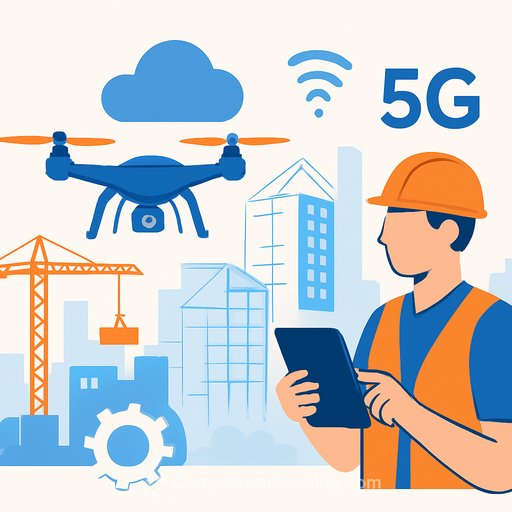Smart Construction Drones: 2025-2029 Outlook and the Moves Builders Should Make Now
The smart construction drone market is scaling fast. It's projected to grow from $3.31 billion in 2024 to $3.77 billion in 2025, then to $6.33 billion by 2029 at a 13.8% CAGR. For construction and real estate teams, this isn't hype-it's a practical toolset for schedule certainty, safer sites, and data you can act on.
Why demand is rising
- More infrastructure projects driven by urbanization and public investment.
- Labor shortages pushing automation and remote workflows.
- Thermal imaging and inspection use cases moving from R&D to daily operations.
- Automated progress reporting tied to BIM and project controls.
- Clearer commercial drone rules and greater focus on lowering carbon on-site.
What this means for your projects
- Faster surveys and earthwork quantification with photogrammetry and LiDAR payloads.
- Daily or weekly progress tracking that lines up with schedules and pay apps.
- Higher safety standards through remote inspections of roofs, facades, and hard-to-reach assets.
- Thermal scans to catch moisture, envelope leaks, and electrical hotspots early.
- Consistent documentation that reduces disputes and rework.
Key tech trends to plan for
- AI/ML onboard for autonomous flight paths, anomaly detection, and instant insights.
- Digital twin integration for real-time models you can compare against design and schedule.
- 5G-enabled drones for low-latency streaming and faster data offload.
- Drone swarms coordinating surveys, counts, and inspections across large sites.
- Convergence with robotics to support smart site automation and coordinated workflows.
Market size and regions at a glance
- 2024: $3.31B → 2025: $3.77B → 2029: $6.33B (13.8% CAGR).
- North America led in 2024; Asia-Pacific is set to grow the fastest through 2029.
- Global coverage: Asia-Pacific, Western Europe, Eastern Europe, North America, South America, Middle East, Africa.
- Report length: 250 pages; forecast period: 2025-2029.
Where drones fit in your tech stack
- BIM and digital twins for as-built vs. as-planned comparisons.
- GIS and CDEs for centralized geospatial data and versioned deliverables.
- Project controls and ERP for automated progress and quantity updates.
- Safety systems for incident prevention and compliance evidence.
Buyer's checklist
Match platform and payload to the job, site size, and regulatory constraints.
- Types
- Fixed Wing: conventional, VTOL, solar-powered (range and endurance).
- Rotary Wing: single rotor, multi rotor (precision and vertical lift).
- Hybrid: fixed-wing VTOL, rotary-fixed wing, tilt-rotor (flexibility).
- Payload capacity
- Lightweight: up to 5 kg.
- Medium: 5-15 kg.
- Heavyweight: more than 15 kg.
- Applications
- Surveying, mapping, inspection, monitoring, construction site management.
- End-users
- Construction companies, real estate developers, engineering firms, government agencies, infrastructure firms.
Vendors featured in the report
- Komatsu Ltd.
- DJI Technology Co. Ltd.
- Yuneec International Co. Ltd.
- AeroVironment
- Topcon Positioning Systems Inc
- Skydio Inc.
- Microdrones GmbH
- Autel Robotics Co. Ltd.
- DroneDeploy Inc.
- Wingtra
- Parrot SA
- Garuda Aerospace
- Airobotics Ltd.
- Delair
- TraceAir
- Draganfly Innovations Inc.
- senseFly SA
- Skycatch Inc
- IdeaForge Technology Ltd
- Kespry Inc
- JOUAV
90-day action plan
- Pick 2-3 use cases: topographic survey, progress capture, facade/roof inspection.
- Select platform by site size and deliverable: fixed wing for coverage, multi-rotor for detail, hybrid for mixed sites.
- Confirm compliance (pilot licensing, airspace, waivers). See FAA commercial UAS.
- Define the data pipeline: capture → process → QA → publish to BIM/CDE → report.
- Train your crew on flight ops, photogrammetry, and safety checklists.
- Set KPIs: survey turnaround time, rework reduction, inspection coverage, schedule variance.
- Scale with SOPs, standard payload kits, and integrations to scheduling and cost systems.
Report scope and access
For full segmentation, regional details, and vendor comparisons, view the Smart Construction Drone Market Report 2025 here: ResearchAndMarkets.com.
Level up your team's AI skills
If you're integrating AI-enabled drone workflows with BIM, scheduling, or inspections, upskilling your team pays off. Explore focused training paths here: Complete AI Training - Courses by Job.
Your membership also unlocks:






